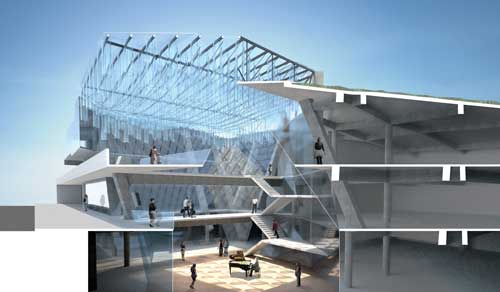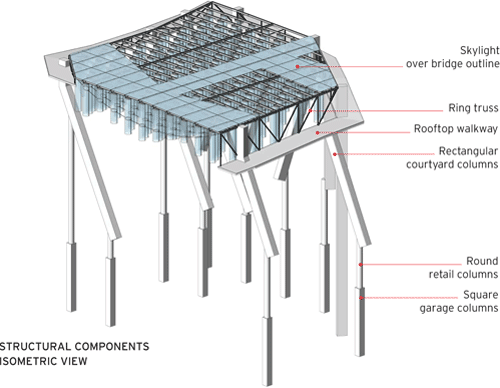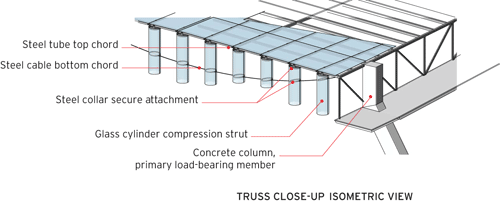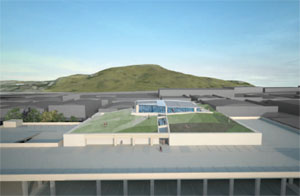Into Thin Air
< page 5 >
California dreaming
While SANAA's Serpentine Pavilion uses a forest of thin steel rods to support a cloudlike roof, a project by Eric Owen Moss Architects (EOMA) turns the roof itself into a forest of rods. In this case, however, the rods are laminated glass cylinders.
EOMA developed the roof concept five years ago for its competition entry to enclose the Robert and Arlene Kogod Courtyard at the Smithsonian Institution Patent Office Building in Washington, D.C. - a project eventually awarded to, and completed by Foster + Partners [RECORD, March 2008, page 98].
 |
|
The innovative glass roof brings light deep into the courtyard and retail spaces (top). The 196 glass rods vary in length (right). Images: Eric Owen Moss Architects |
 |
Â
"The competition asked for an innovative roof that pursued a different conception of glass," recalls Moss. "Glass is an ethereal material that isn't really there. I wanted to juxtapose something ethereal with a supporting structure. That was the center of the exploration, to test the limits of what glass could do."
Moss's ethereal exploration found new life when a developer wanted to pursue it for a mixed-use structure in Culver City, California, a former industrial area now populated by media, entertainment, and production companies. The project, which was recently approved for construction by the city's planning department, features five levels of parking for 800 vehicles (three underground and two above ground) and 50,000 square feet of retail space positioned on three floors around an open courtyard.
 |
Isometric views of the roof structure in EO MA's mixed-use project detail its various components. Images: Eric Owen Moss Architects |
 |
Â
The courtyard is topped by a dense vertical field of glass rods that offers a constantly changing vision of light and sky through an expanse of shimmering glass. The glass walls of the courtyard incline to maximize sunlight to the retail spaces.
But EOMA's design, developed in its various incarnations using CATIA software, goes beyond a conventional glass skylight to incorporate acoustical and structural properties. Sound is diffused within the array of 196 rods, which vary in length from 6 to 14 feet. Plugged cylinders act to reflect sound. (Moss and the developer anticipate musical performances in the courtyard.)
The long-span structural system used throughout the rest of the building is interrupted by the walls of the courtyard. Its innovative, composite roof features structural glass trusses spanning east-west between five steel trusses. The steel trusses are supported by 10 canted, rectangular columns positioned around the court walls. A horizontal glass skylight over the structural members partially encloses the court and provides weather protection for the walkways and stairs located beneath it. A green roof will cover the third-floor retail area surrounding the courtyard enclosure.
 |
The courtyard's glass roof rises from the green roof around it. Image: Eric Owen Moss Architects |
The glass truss is an unprecedented composite assembly combining a hollow-steel-tube top chord, a 5â„8-inch-diameter stainless-steel-cable bottom chord that forms a catenary curve, and vertical members consisting of the laminated glass rods acting in compression within the truss.
The cylinders themselves, specified with 1â„2-inch-thick structural glass, are attached by a pin connection to the steel tube, or top chord, above them. A stainless-steel collar wraps around the inside of the cylinder at the location where the cable passes through it. Two methods for attaching the collar to the cylinder were explored. A simple bolted application is one option. An alternative method is to secure the attachment through a direct lamination between the steel and glass.
Though prototypes of the cylinders, which are planned to be 2 feet in diameter, have been made, EOMA is currently investigating glass fabricators in several countries that would produce the structural glass on a large scale.
"While the glass roof does all of these things - technically, structurally, acoustically - none are immediately intelligible as objectives," explains Moss. "It obviates the meaning of structure and is, instead, an experience of space."








